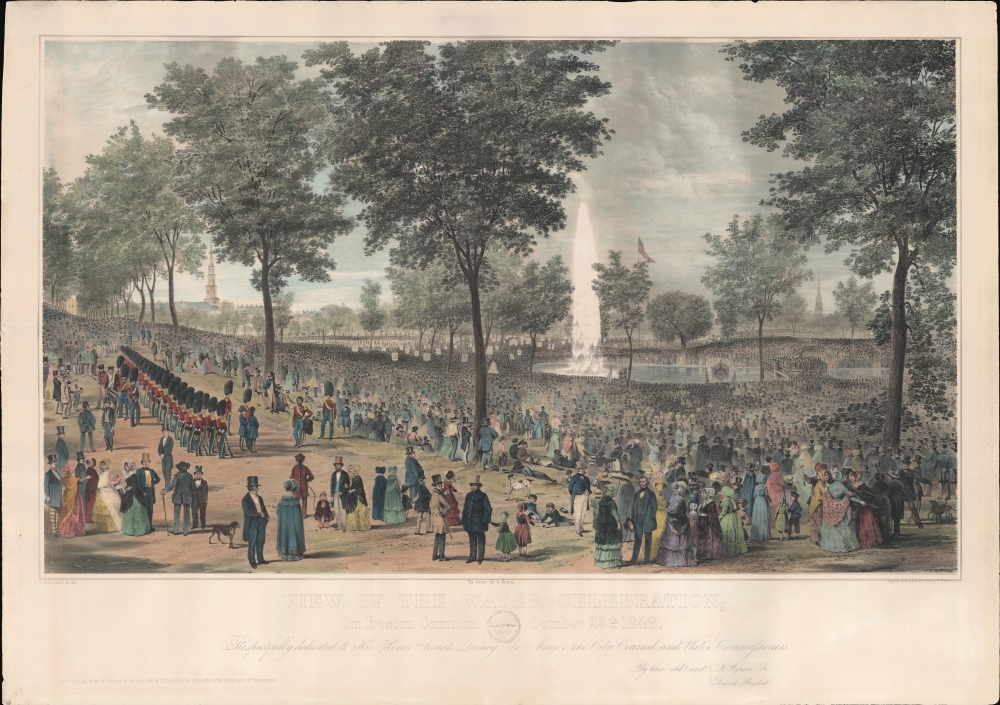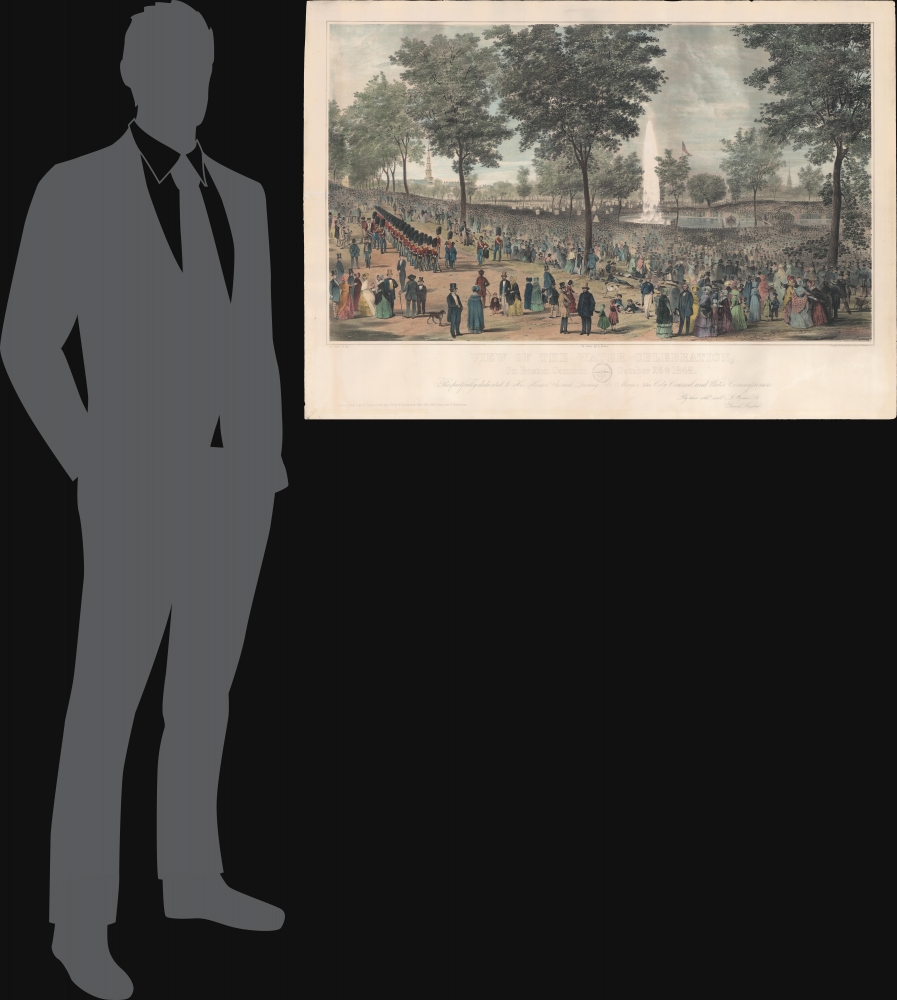1849 Smith / Rowse View of Boston Common Water Celebration
BostonCommonWater-bigelow-1849
Title
1849 (dated) 28.25 x 38.5 in (71.755 x 97.79 cm)
Description
A Closer Look
Oriented roughly towards the east, the view looks out over Boston Common, focusing on the body of water that today is called the Frog Pond (now known, among other things, for ice skating in the winter months). The church at left is the Park Street Church while the more distant and indistinct church at right is likely the Old South Meeting House. The view is finely executed and highly detailed, with the faces and clothing of people in the foreground being especially realistic.The large crowd seen here was gathered to celebrate the opening of Boston's (and one of the nation's) first publicly-administered piped water systems. In addition to the mayor, Josiah Quincy, Jr. (to whom the view is dedicated), and Daniel Webster, one of Massachusetts' two U.S. Senators, representatives of Boston's elite were prominent in the festivities. The crowd reflects a cross-section of Boston's society and its cosmopolitan mix of peoples, including African-Americans and a Chinese man with the distinctive ponytail (辮子) of the era (Boston's historic Chinatown is a very short walk from Boston Common).
Water Wars
The water system was a significant improvement in the daily lives of thousands of city residents, but it only came after years of intense, heated debate as the water question became a symbol of much deeper, fundamental disagreements about the role of government in society. Prior to 1848, a private company piped water from Jamaica Pond for those who could afford it. Other residents had to source water from wells or door-to-door water sellers. Others simply scooped water from the Charles River, which at the time was filled with sewage and garbage.All these methods were insufficient for the city's growing population and most of them were heavily polluted by the early 19th century. A public water system was also desirable as it could help contain fires, which were frequent and occasionally burned down entire sections of the city. Proposals for a new system of publicly administered aqueducts and reservoirs began in the 1820s, but were strenuously opposed by interests ranging from the established water companies to other businesses and individual citizens who opposed the idea on principle and saw the provision of water as something better left to private enterprise. The issue divided the public and the first referendum to establish such a public water system failed. Eventually, in 1846, the state legislature approved a plan to build a state-of-the-art system of aqueducts and reservoirs to channel water into the city from Long Pond - now Lake Cochituate - 19 miles west of Boston. Work began in late August that year and was completed a little over two years later.
As a form of catharsis at the end of such a bitter struggle, the opening of the water system was celebrated with a large parade and a ceremony on the Common with speeches by local grandees, seen here. (A figure, possibly representing Quincy, stands on a stage or bridge erected over the center of the pond at right). Rough estimates are that a solid majority of the city's population turned out, along with visitors from throughout New England, and some were so overcome with emotion that they cried tears of joy.
Publication History and Census
This view was drawn by Benjamin Franklin Smith, transferred to stone by Samuel Worcester Rowse, and printed in 1849 by Tappan and Bradford. It is copyrighted to L. Wyman Jr. and David Bigelow. Examples are held by the Boston Athenaeum, the Library of Congress, the American Antiquarian Society, the New York Public Library, the National Museum of American History, Historic New England (Josiah Quincy House), and the Boston Public Library. Most of these institutions have digitized their examples, allowing for easy comparison. Those resembling the present example, with extensive, vibrant hand-coloring, are especially scarce.CartographerS
Benjamin Franklin Smith (1830 – 1927) was an artist, printer, and publisher of American city views active in the mid to late 19th century. Smith was born in South Freedom, Maine where he grew up on the family farm. His work is most commonly associated with his brothers, all of whom worked in the view-making industry, publishing both individually and separately as Smith Brothers. His brothers were Francis Smith, George Warren Smith, and David Clifford Smith. Among the brothers Benjamin, the youngest, was the most artistic, producing views as early as 1846, when he was 16. He drew his first city view, Albany as seen from the Hudson, at 17. Benjamin and his brothers initially worked as sales agents for viewmaker Edwin Whitefield. In 1849, the Smiths broke with Whitefield and began publishing under their own imprint, Smith Brothers. Benjamin Franklin drew at least four of the Smith Brother's views, and possibly significantly more. Reps suggests that the firm stopped publishing in 1855, but at least two important views, the 1857 Smith-Hill-Mottram view of Boston and the 1862 Smith view of Elmira, were issued later. Although both bear the Smith Brothers imprint, they were copyrighted by Benjamin Franklin Smith and are more likely than not, unassociated with the other brothers and their earlier views. In any case, the Smith firm was sold at an enormous profit in 1855, making the family extremely wealthy. They furthered their fortunes by investing in railroads. At the time of his death in 1927, Benjamin Franklin Smith was believed to be the richest man in Maine. More by this mapmaker...
Samuel Worcester Rowse (January 29, 1822 - May 24, 1901) was an artist, engraver, and lithographer who spent most of his life and career in Boston, Massachusetts. Census records and obituaries disagree on whether he was born in Maine or New York, but he was raised and began his career in Maine. Though Rowse originally worked as an engraver, he moved to Boston in 1852 and opened a lithography studio. But he became best-known for pastel and charcoal portraits of leading intellectuals and political figures of the day. He traveled in the same intellectual circles as Ralph Waldo Emerson, Henry David Thoreau, Nathaniel Hawthorne, and Henry Wadsworth Longfellow, and drew celebrated portraits of each. Rowse was also associated with the abolitionist movement, and produced a famous lithograph in 1850 titled 'The Resurrection of Henry Box Brown at Philadelphia,' based on the story of an enslaved man who escaped to freedom by hiding in a box being mailed from Richmond, Virginia, to Philadelphia. Rowse traveled widely, relocating from Boston to New York in 1880, and briefly living in London and Paris at various points of his life. Learn More...
Lodowick Harrington Bradford (November 10, 1820 - December 13, 1885) was a Boston based engraver lithographer active in the second half of the 19th century. Bradford was born in Boston, Massachusetts. He studied as a line engraver before transitioning to the then new art of lithography. He even invented his own photolithographic ambrotype process that created a durable photographic picture on lithographic stone. In 1849 he partnered with Ebenezer Tappen (1815 - 1854) to form the Boston firm of Tappan and Bradford. The partnership remained active until Tappan's untimely death in January, 1854. From 1854 to 1859 Bradford continued to operate the firm, but the imprint changed to 'L. H. Bradford and Company.' It is not clear who the 'and Company' was, possibly Tappan's heirs? From late 1859 until his 1870, he printed under 'L. H. Bradford.' His last known lithographs appeared in 1860, but he did continue copper and steel engraving until his death. Bradford was married to Martha Brown, from an old Gloucester Family. After his wedding in 1849, he divided his time between Gloucester and Boston. In Gloucester he made the acquaintance of the local painter Fitz Henry Lane (1804 - 1865) and worked with him to produce several views in the 1850s. He died on the road between Boston and Gloucester in 1885. Learn More...




